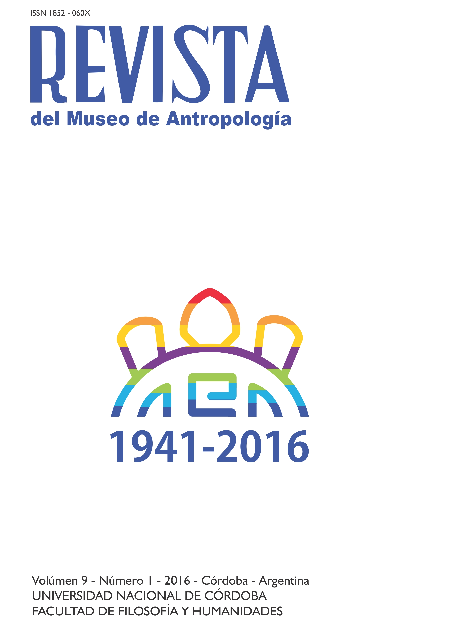Music and dance as particiapative spaces among young children of migrant Bolivians and Paraguayans in Buenos Aires (Argentina)
DOI:
https://doi.org/10.31048/1852.4826.v9.n1.12374Keywords:
nusic and dance, second-generation immigrants, social Participation, cultural identificationAbstract
This article is partially based on my PhD thesis, which used an anthropological approach to study identifications and ways of participation among “second-generation” immigrants in Argentina’s city capital. The present analysis will take up some aspects of those ways of participation among second-generation Bolivians and Paraguayans in Buenos Aires, starting from the study of their artistic and cultural practices linked to their parents’ origin, specially music and dance. Taking into account identification processes among the generation of the descendants, this article will place those artistic practices and these youth participation within the frame of current socio-political situations and changes (that go beyond the local and the national level to reach the trans/international space). The final aim is to elaborate a broader definition of “the political”, that will not be limited to traditional ways of social and political participation, in order to create key elements to understand music and dance as tools for transformation, especially among urban working class young people.Downloads
References
Bauman, R., & Briggs, C. L. (1990). Poetics and Performance as Critical Perspectives on Language and Social Life. Anual Review of Anthropology, 19(1), 59-88. DOI: https://doi.org/10.1146/annurev.an.19.100190.000423
Blacking, J. (1979). The Performing Arts - Music and Dance. La Haya, Holanda: Mouton. DOI: https://doi.org/10.1515/9783110800692
Citro, S. (2009). Cuerpos Significantes. Buenos Aires: Biblos.
Foner, N. (2009). Introduction: Intergenerational Relations in Immigrant Families. En Across Generation: Immi-grant Families in America. New York: New York University Press.
Gavazzo, N. (2002). La Diablada de Oruro en Buenos Aires. Cultura, identidad e integración en la inmigración boliviana. Universidad de Buenos Aires.
Gavazzo, N. (2010). Como si fuera mala palabra”: Un panorama de la discriminación en el Área Metropolitana de Buenos Aires. En M. I. Pacecca & C. Courtis (Eds.), Diagnóstico participativo sobre discriminaciones étnico-nacionales y religiosa (pp. 13-36). Buenos Aires: Del Puerto editores y Asociación por los Dere-chos Civiles.
Gavazzo, N. (2012). Hijos de bolivianos y paraguayos en el área metropolitana de Buenos Aires. Identificaciones y participación, entre la discriminación y el reconocimiento. Universidad de Buenos Aires.
Grimson, A. (2011). Los Límites de la Cultura. Buenos Aires: Siglo XXI.
Grimson, A. (2006). Nuevas xenofobias, nuevas políticas étnicas en Argentina. En A. Grimson & E. Jelin (Eds.), Migraciones regionales hacia la Argentina. Diferencia, desigualdad y derechos. Buenos Aires: Pro-meteo Libros.
Infantino, J. (2008). El arte como herramienta de intervención social entre jóvenes en la ciudad de Buenos Ai-res. La experiencia de ‘Circo Social del Sur’. En Medio Ambiente y Urbanización. No 69. Niños, niñas y jó-venes como agentes de cambio. (pp. 35-54). Buenos Aires: Instituto Internacional de Medio Ambiente y Desarrollo, IIED.
Kunin, J. (2009). Rap político en el altiplano boliviano: (Re)Construcción de identidades juveniles y de ciuda-danía afirmativa a través de negociaciones en un mundo globalizado. En Temas de patrimonio cultural, no 24: Buenos Aires Boliviana. Migración, construcciones identitarias y memoria (1era ed.). Buenos Aires: Comisión para la Preservación del Patrimonio Histórico Cultural de la Ciudad Autónoma de Buenos Aires.
Levitt, P., & Waters, M. (2002). The Changing Face of Home. The Transnational Lives of the Second Generation. New York: Russell Sage Foundation.
Mardones, P. (2010). Volveré y seré millones. Migración y etnogénesis Aymara en Buenos Aires. Universidad de Buenos Aires.
Olivera, C. (2009). ¿Bailando por un sueño? Espacio de construcción de identidades. En Temas de patrimonio cultural, no 24: Buenos Aires Boliviana. Migración, construcciones identitarias y memoria (1era ed.). Buenos Aires: Comisión para la Preservación del Patrimonio Histórico Cultural de la Ciudad Autónoma de Buenos Aires.
Vargas, J. (2006a). Matices cruzados en nuestras dicotomías actuales: civilización y barbarie, Facundo y las morenadas. Buenos Aires.
Vargas, J. (2006b). La tierra no es sólo la Pachamama. En Seminario Migraciones y Ciudadanía Rosario. Rosa-rio.
Wright, S. (1998). La politización de la “cultura”. Anthropology Today, 14(1), 7-15. DOI: https://doi.org/10.2307/2783092
Yúdice, G. (2000). Redes de gestión social y cultural en tiempos de globalización. En D. Mato, X. Agudo, & I. García (Eds.), América Latina en tiempo de globalización II: Cultura y transformaciones sociales. Caracas: UNESCO-Instituto Internacional para la Educación Superior en América Latina y el Caribe (IESALC).
Downloads
Published
How to Cite
Issue
Section
License
Those authors who have publications with this Journalaccept the following terms:
a. Authors will retain their copyrights and guarantee the journal the right of first publication of their work, which will be simultaneously subject to the Creative Commons Attribution License (Licencia de reconocimiento de Creative Commons) that allows third parties to share the work as long as its author and his first publication in this journal.
b. Authors may adopt other non-exclusive licensing agreements for the distribution of the version of the published work (eg, deposit it in an institutional electronic file or publish it in a monographic volume) provided that the initial publication in this journal is indicated.
c. Authors are allowed and recommended to disseminate their work on the Internet (eg in institutional telematic archives or on their website) before and during the submission process, which can lead to interesting exchanges and increase citations of the published work. (See The Effect of Open Access - El efecto del acceso abierto)












